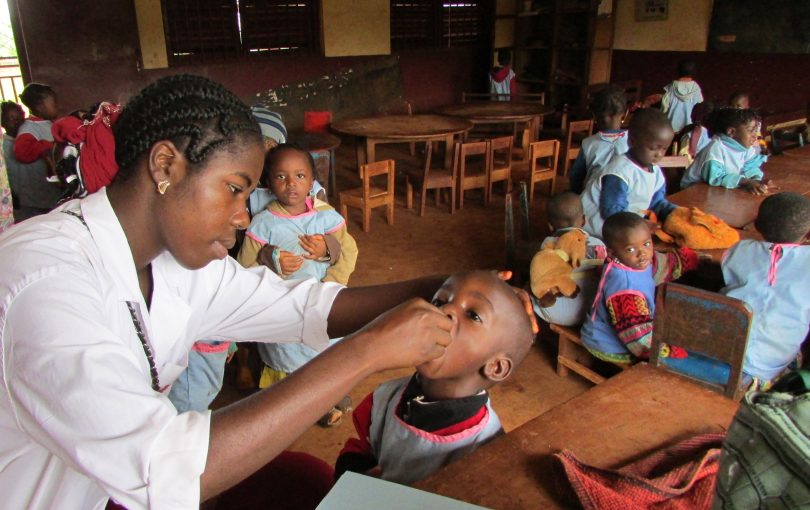It is a shocking fact that half of all children born in Syria in the past 12 years haven’t received all the necessary vaccines as part of the basic immunisation schedule. The chances of a child surviving to adulthood in the north of the country are reduced, as they are unlikely to ever receive the necessary pneumonia and diarrhoea vaccines to protect them from these diseases that are so dangerous to young lives. These vaccines are not available through public healthcare services, and they are simply unaffordable for conflict-affected families to buy privately. If the child lives in a displacement camp, or has had to flee with their family from one camp to another to escape bombs, they are likely to be part of the so-called “zero-dose children” group.
And this is not just a problem in Syria. More than 18 million children did not receive any kind of vaccine in 2021 – not a single dose, nothing. Compared to the numbers of children accessing vaccination in 2019, five million more children went without vaccines in 2021. That’s a 37% increase over a two-year period. Vaccination levels fell in more than a hundred countries, leading to an increase in outbreaks of measles, diphtheria and polio. We’ve not seen such low figures of childhood immunisation since 2005.
This historic setback in childhood immunisation, which is largely due to the effects of the COVID-19 pandemic, has put many more children at risk of contracting vaccine-preventable diseases. We have lost more than a decade of progress in just three years.
Vaccination became a “collateral casualty” of COVID-19, especially in the first year of the pandemic. It was the most frequently limited or interrupted activity among the essential health services during the pandemic. Dozens of countries saw routine vaccination campaigns against measles and rubella, to cite two examples, interrupted and suspended, and vaccination resources subsequently shifted to immunisation against COVID-19.
Another, though lesser, factor to take into account is the scepticism generated towards the coronavirus vaccine, which may have had a “contagion effect” in decreasing confidence in other vaccines.
Low and middle income countries experienced a greater decline than higher income countries. Gavi, the Vaccine Alliance, has been providing vaccines and support to low and middle income countries since 2000. Gavi itself estimates that there are 12.5 million children who have not received a single basic vaccine in Gavi-eligible countries.
Six out of ten children who have received zero doses live in just 10 countries. Half of them, including the Democratic Republic of Congo, Ethiopia, India, Indonesia and Nigeria, participated in the 2nd Global Forum on Childhood Pneumonia held in Madrid last week.
Pneumonia and rotavirus are among the top childhood fatal diseases. Together they account for 23% of all deaths worldwide among children under five. They disproportionately affect poor and marginalised children, who often live in fragile or conflict-affected contexts and face multiple risks, including food insecurity and lack of access to quality health care, safe water and sanitation.
These two vaccines are key to driving significant reductions in child mortality. Prevention is crucial as, for example, only 18% of children with symptoms of pneumonia are treated.
Somalia, which was also present at the Madrid forum, is home to 288,000 zero-dose children. It needs to reduce its under-five child mortality rate per 1,000 live births from 119 to 25 (by almost 500%) by 2030 to achieve the Sustainable Development Goal – a target that, let’s not forget, represents lives.
By introducing just the pneumococcal conjugate and rotavirus vaccines (which protect against pneumonia and diarrhoea), Somalia could prevent 35,000 child deaths by 2030. The example of Somalia, a country in protracted conflict, is not unique. These two vaccines could prevent the loss of 40,000 lives in Chad, 16,000 in South Sudan and 12,000 in Guinea over the same period.
Statistics are essential for defining public health problems and parameters, but they can also dehumanise. They don’t convey the pain felt by the death of every individual child. Yet the magnitude of the numbers should shock and mobilise us to try to save every one of these lives. Every preventable child death is not only a failure of the immunisation system, but also an injustice that violates the most basic right of childhood: the right to protection.
We need a global push to reach the millions of children left behind in the worst years of the pandemic – but also, those who missed their chance before 2020 due to conflict and other humanitarian crises.
These missing three years mean that many of these zero-dose children are already more than a year old. Combined efforts need to focus on reaching children up to at least five years of age.
To do this, Gavi must adapt its policy to allow countries to vaccinate more children who have had zero doses or are underimmunised. Gavi generally provides vaccines at a reduced price under a co-payment system in low and middle income countries until the child is one year old. Changing the policy to vaccinate children up to at least five years of age (in line with World Health Organization recommendations) is critical in countries in humanitarian crisis, where there are large pockets of zero-dose children.
In addition, we need Gavi to remove the co-financing requirement for countries with fragile health systems or in humanitarian crises. This is especially important in states experiencing complex crises, with large pockets of children who have never received a vaccine in their lifetime.
If the global architecture to support immunisation programs is not able to adapt to the needs of countries with health systems weakened by these crises, efforts to recover children from zero doses will continue to exclude those most in need, the most vulnerable. All children have a right to protection, regardless of their age or where they live. Adding any other selection criteria contributes to maintaining the injustice of preventable child deaths. Zero-dose children deserve more.



Leave a Comment